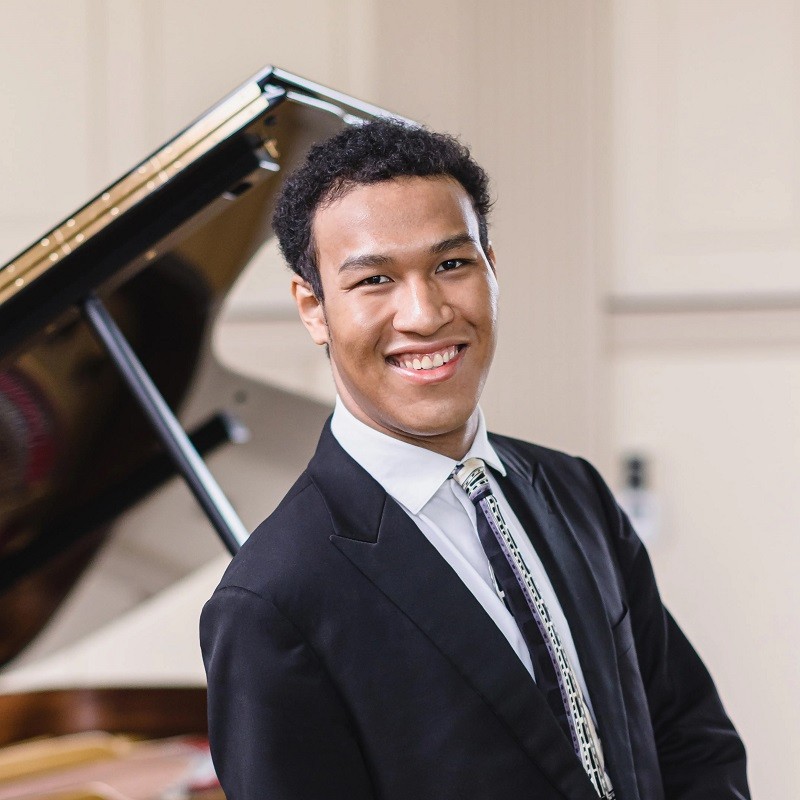Clayton Stephenson | Sunday, March 9, 2025 · 4:00pm | Salon Piano Series | Concert in Madison, WI

Clayton Stephenson
Sunday, March 9, 2025 · 4:00pm
Program included: Albéniz, Arlen/Jarrett, Schubert, Stravinsky
Hailed for his “extraordinary narrative and poetic gifts” and interpretations that are “fresh, incisive and characterfully alive” (Gramophone), American pianist Clayton Stephenson was the first Black finalist at the Van Cliburn International Piano Competition.

Program
Schubert: Four Impromptus, D. 899, Op. 90
Arlen/Jarrett: “Over the Rainbow”
Albéniz: Iberia, Book I
Stravinsky: Trois mouvements de Petrouchka
Masterclass
Concert Review
It is always a special pleasure to be introduced to an outstanding young pianist in a solo recital. The audience at Clayton Stephenson’s Madison debut on Sunday afternoon was fortunate to hear a superb program which demonstrated not only Mr. Stephenson’s fearless and brilliant technical mastery of the keyboard, but also his obvious love of the music he was playing, his delight in his own virtuosity, as well as his willingness to play with his own voice and vision. He has the command and confidence to express his own ideas about the works he played on his stylistically varied program.
He began with the first set of four Impromptus that Franz Schubert composed in 1827. Mr. Stephenson commented on the background of these beloved pieces, mentioning that when the third of the set was first published (many years after the first two) the publisher issued it in the key of G major, rather than G-flat, the key of Schubert’s own original version. Stephenson even let the audience hear the opening measures in each of those keys, giving a brief but vivid demonstration that the character of the composer’s chosen key really does make a difference! G major is brighter, somewhat “happier”, but G-flat is mellower, warmer, and incidentally more comfortable for the player, with its many black keys. This was one of many instances during the afternoon when Mr. Stevenson showed himself to be a gracious and informative host to this musical feast, giving the audience special insights by introducing each piece on the program with charm and enthusiasm.
Mr. Stephenson played all four of the Impromptus with much affection, and explored the wide dynamic range that Schubert demands. The first of the set was played like a somber journey through a winter landscape, reminiscent of the songs of “Winterreise”, the great cycle that was written in the same year. The second, a roller-coaster etude for the pianist’s right hand, suitably alternated between silky arabesques and violent outbursts. The third impromptu is perhaps the most challenging of the group, as the performer must “sing” with the 4th and 5th fingers of his right hand, while maintaining a “babbling brook”- like accompaniment with the remaining three fingers. It is important also to observe the composer’s tempo – a double “alla breve”, which should be quick enough to sustain the energy and flow of the accompaniment, while allowing for subtle phrasing, breathing, and many abrupt changes in dynamics. Mr. Stephenson’s subtly expressive playing rose to these challenges and he finished the first half of the concert with the enchanting fourth Impromptu - also a study in contrasts with sparkling “waterfalls” in the right hand that alternate between major and minor, and a boldly dramatic middle section projecting a tragic character. Mr. Stephenson again demonstrated his love for the music and gave a committed performance.
After intermission, the audience was given a demonstration of the breadth of Mr. Stephenson’s repertoire, as well as his abundant and joyful virtuosity. First, he enchanted us with the gentle intimacy of Keith Jarret’s arrangement of “Over the Rainbow”, which is a classic in its own right. Stephenson played it as if he himself were creating his own improvisation, as he explored Jarret’s take on this famous journey to a magical place. Having traveled almost to Oz and back, we were transported to a completely different and fascinating world in the first three pieces from one of the crown jewels of Spanish music - “Iberia”-by Isaac Albeniz. This is music which is a notoriously formidable test for any virtuoso pianist. Critic Donal Henahan once wrote: “There is really nothing in Isaac Albeniz’s Iberia that a good three-handed pianist could not master, given unlimited years of practice and permission to play at half tempo. But there are few pianists thus endowed.” Mr. Stephenson demonstrated that his two hands – and feet! -were quite up to the task as he took us on an atmospheric and exciting tour of the first “book” of this extraordinary collection: the three pieces entitled “Evocación”, “El Puerto” and “Fête-dieu à Séville”. He seemed totally at home with the unique colors and rhythms of the music, and their improvisatory flow– as heir to the throne once occupied by the great Spanish pianist Alicia de Larrocha.
Incredibly, Mr. Stephenson’s demonstration of his ability to play just about anything was not over! Igor Stravinsky’s own piano transcription of three scenes from his ballet “Petrouchka” is, if anything, an even more formidable challenge. Again, Stephenson took time to give us the background of the piece and shared the story of the three puppets brought to life by a magician at St. Petersburg’s Shrovetide Fair, and the tragic love triangle that ensues. This is a piece that can only be attempted by a pianist with chops to burn, who has a keen ear for color, variety of touch, mastery of subtle pedaling, razor sharp rhythmic precision, and a certain fearlessness and confidence that evokes Olympic athleticism at its most astounding. Stephenson’s playing had all those qualities and more. We never missed Stravinsky’s orchestra, as Stevenson’s brilliant fingers, ears and imagination created a dazzling canvas of orchestral sonorities within the framework of the composer’s remarkable piano transcription.
Of course, this level of playing deserved and received an instantaneous standing ovation. Mr. Stephenson smiled and indicated he had just a little more to share – and to our delight, launched into a piece by Japanese composer Hiromi Uehara – called “Tom and Jerry Show” – a perfect romp that evokes the hilarious antics (often around a keyboard) by the famous cartoon cat and mouse duo. It was an amazing run around the keyboard, leaving us breathless with laughter and wonder, and gratitude for the afternoon of outstanding music-making by a young artist from whom we will surely be hearing much more in the future. No doubt about it – Clayton Stephenson is a very special pianist, and kudos to Salon Piano Series for bringing him to Madison. May he return often!
A Footnote:
Renee Farley shared some interesting information with me about the tuning used for Clayton Stephenson’s recital. The tuning for the 1907 Mason and Hamlin concert grand was the 1/7 syntonic comma modified meantone, developed by the 18th century French theorist Jean-Baptiste Romieu.
This tuning was shown to Peter Serkin by Tim Farley. Serkin became so enamored with its expressive qualities that he used it for his concerts all over the world.
Review by Bill Lutes
